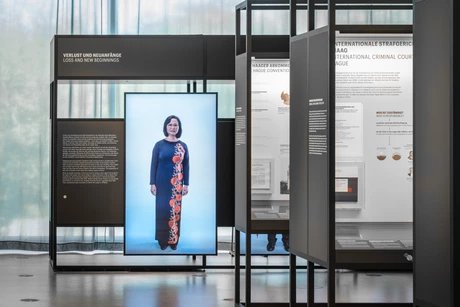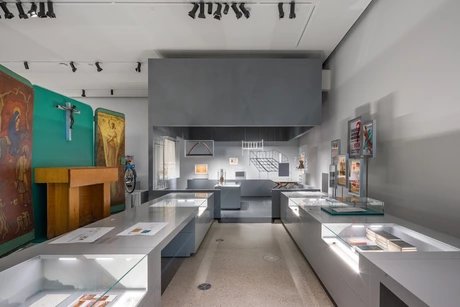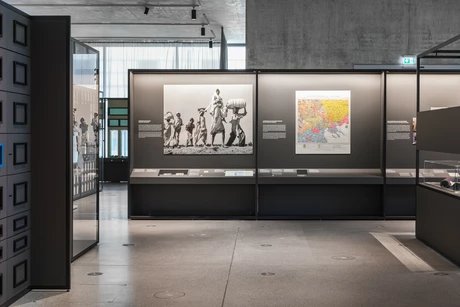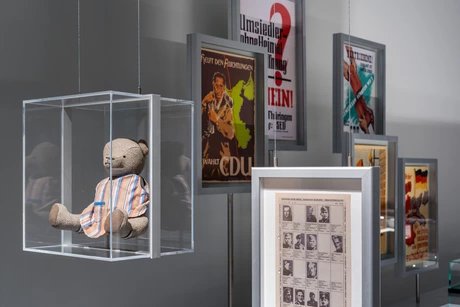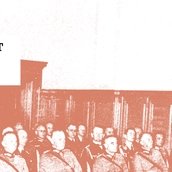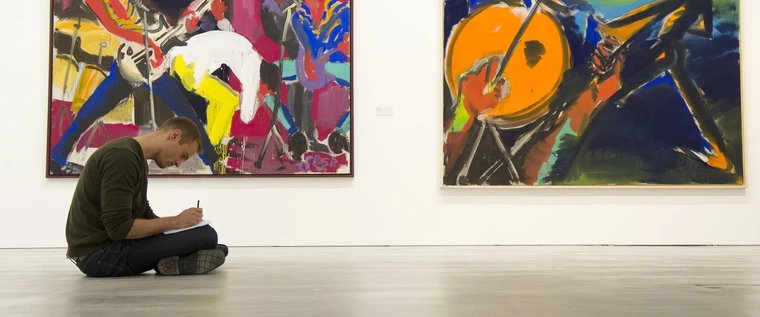
Permanent exhibition
The exhibition depicts a European history of forced migrations from the
20th century to our own time. The focus is on the flight and expulsion of around 14 million Germans in the historical context of the Second World War and National Socialist policies.
Around 700 exhibits are on display on approximately 1500 square metres of exhibition space over two floors. Most of the originals come from the Documentation Centre's collection. In addition, there are 45 international loans. 140 maps support the geographical orientation and 250 photos make a complex topic vivid. 65 media stations, some of them interactive, are available.
A European history of forced migrations
On the first floor, six themed islands provide an introduction and overview of the subject. They can be discovered in any order. Using numerous examples from the 20th century to the present, this section deals with the causes, phenomena and consequences of forced migrations, primarily in Europe - but also beyond. The audience encounters Germans as both perpetrators and victims of expulsions. Films, images and objects make the experiences of refugees and displaced persons directly vivid.
How are the idea of nation and nationalism connected? Why are minorities particularly often affected by expulsions? How is it that today expulsions are internationally punishable? What are the experiences of refugees and displaced persons on the run? What does life in camps mean for these people? How do they manage to make a new start after losing their homeland? And why is the memory of forced migrations often so controversial?
Flight and expulsion of the Germans
The second floor takes an in-depth look at the flight and expulsion of the Germans. A chronological tour leads the audience through three successive areas.
At the beginning, National Socialist politics, the Second World War, the German occupation of Europe and the murder of European Jews are discussed. A wall-filling installation documents the plans of the Allies for the expulsion of the Germans during the war up to the decisions of the Potsdam Conference. On the basis of often personal testimonies, the exhibition then deals with evacuations and the mass flight of Germans from the Red Army.
The second section focuses on expulsions as a means of reorganizing Europe by the victorious powers and the East Central European states. Around 14 million Germans from the former German eastern territories and the south-eastern European settlement areas were affected, as well as millions of people from Poland, the Ukraine and Belarus. Personal experiences and fates are brought to life with the help of many exhibits from the Documentation Centre's collection and from lenders from Germany and abroad.
The third section revolves around the arrival and distribution of 12.5 million people as a result of flight and expulsion in the occupation zones in Germany. With numerous originals, documents and media stations, the gradual and not always easy integration of the expellees into the societies of the Federal Republic and the GDR is portrayed. An emphasis is placed on the culture of remembrance. An impressive display case presents 251 objects from a former Sudeten German homeland from Gärtringen near Stuttgart.
The permanent exhibition closes with a European epilogue. Milestones of a new order of states since the end of the Cold War, Germany's understanding with its European neighbours and the return of flight, expulsion and ethnic cleansing as a result of the Yugoslavian wars in Europe all resonate here. The founding history of the Foundation Flight, Expulsion, Reconciliation is also taken up.
Free Admission
Around 700 exhibits are on display on approximately 1500 square metres of exhibition space over two floors. Most of the originals come from the Documentation Centre's collection. In addition, there are 45 international loans. 140 maps support the geographical orientation and 250 photos make a complex topic vivid. 65 media stations, some of them interactive, are available.
A European history of forced migrations
On the first floor, six themed islands provide an introduction and overview of the subject. They can be discovered in any order. Using numerous examples from the 20th century to the present, this section deals with the causes, phenomena and consequences of forced migrations, primarily in Europe - but also beyond. The audience encounters Germans as both perpetrators and victims of expulsions. Films, images and objects make the experiences of refugees and displaced persons directly vivid.
How are the idea of nation and nationalism connected? Why are minorities particularly often affected by expulsions? How is it that today expulsions are internationally punishable? What are the experiences of refugees and displaced persons on the run? What does life in camps mean for these people? How do they manage to make a new start after losing their homeland? And why is the memory of forced migrations often so controversial?
Flight and expulsion of the Germans
The second floor takes an in-depth look at the flight and expulsion of the Germans. A chronological tour leads the audience through three successive areas.
At the beginning, National Socialist politics, the Second World War, the German occupation of Europe and the murder of European Jews are discussed. A wall-filling installation documents the plans of the Allies for the expulsion of the Germans during the war up to the decisions of the Potsdam Conference. On the basis of often personal testimonies, the exhibition then deals with evacuations and the mass flight of Germans from the Red Army.
The second section focuses on expulsions as a means of reorganizing Europe by the victorious powers and the East Central European states. Around 14 million Germans from the former German eastern territories and the south-eastern European settlement areas were affected, as well as millions of people from Poland, the Ukraine and Belarus. Personal experiences and fates are brought to life with the help of many exhibits from the Documentation Centre's collection and from lenders from Germany and abroad.
The third section revolves around the arrival and distribution of 12.5 million people as a result of flight and expulsion in the occupation zones in Germany. With numerous originals, documents and media stations, the gradual and not always easy integration of the expellees into the societies of the Federal Republic and the GDR is portrayed. An emphasis is placed on the culture of remembrance. An impressive display case presents 251 objects from a former Sudeten German homeland from Gärtringen near Stuttgart.
The permanent exhibition closes with a European epilogue. Milestones of a new order of states since the end of the Cold War, Germany's understanding with its European neighbours and the return of flight, expulsion and ethnic cleansing as a result of the Yugoslavian wars in Europe all resonate here. The founding history of the Foundation Flight, Expulsion, Reconciliation is also taken up.
Free Admission
